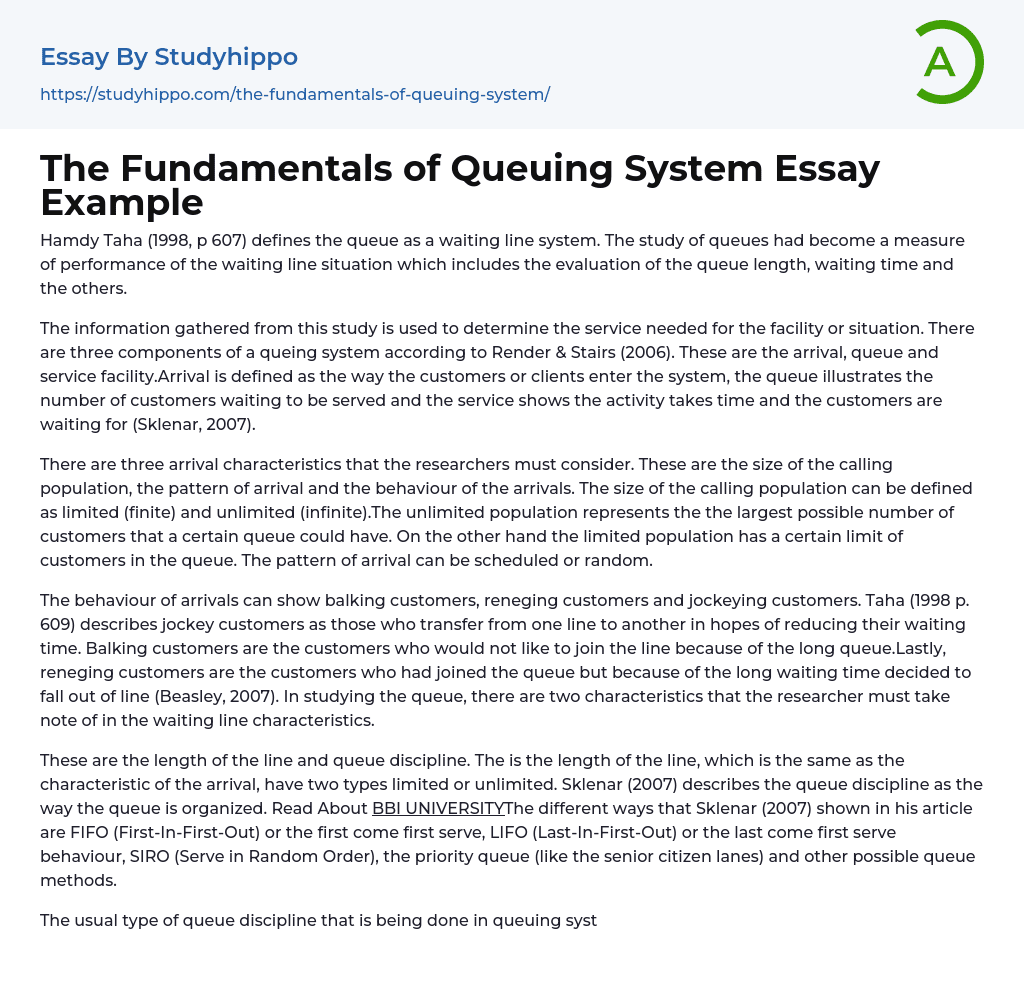According to Hamdy Taha's 1998 book (p. 607), queues are systems that require waiting in line, and studying them helps determine the efficiency of waiting lines by considering factors like queue length and wait times.
Identifying the suitable service for a specific situation or facility is the main objective of this research. According to Render ; Stairs (2006), there are three components that form a queuing system, namely: arrival, queue, and service facility. Arrival refers to how customers or clients enter the system, while queue pertains to the number of customers waiting for their turn. Service represents the actual activity being performed, which may cause customers to wait (Sklenar, 2007).
Researchers have to take into account three arrival attributes: the size of the calling population, the pattern of arrival, and the behavior of arrivals. The size of the c
...alling population can be classified into limited (finite) and unlimited (infinite) populations. An unlimited population refers to the greatest possible number of customers that a specific queue can accommodate, while a limited population has a certain threshold on the number of customers in a queue. The pattern of arrival can be either scheduled or random.
When studying the queue, it is important for researchers to consider various aspects of customer behavior such as balking, reneging and jockeying. According to Taha (1998 p. 609), jockey customers switch lines in order to reduce their wait time. Balking customers avoid joining a long queue while reneging customers initially join the queue but later quit due to long waiting times (Beasley, 2007).
The length of the line and the queue discipline are important factors. The length of the line is determined by the arrival'
characteristic. It can be limited or unlimited, according to Sklenar (2007). The queue discipline refers to the organization of the queue. To learn more, visit
BBI UNIVERSITY
Sklenar (2007) provided several queue methods, such as FIFO (First-In-First-Out), LIFO (Last-In-First-Out), SIRO (Serve in Random Order), priority queue, and others.
The common type of queue management observed in queuing systems follows the First In First Out (FIFO) discipline. The Service Mechanism pertains to the resources necessary for the initiation of service in the queue (Beasley, 2007). There are four factors to consider in the Service Mechanism, such as the service time distribution, number of servers in line, server orientation (either parallel or series), and pre-emption potential.
The assumption underlying pre-emption is that a customer with higher priority interrupts the processing of another. This is typically based on an exponential distribution for customer arrival rates. The expansion of the queue size is influenced by both service time and the level of customer traffic intensity.
The traffic intensity of a system determines the level of congestion, which is determined by dividing the arrival rate by the departure rate. As traffic intensity increases, so does queuing. Queuing systems are common in various settings such as purchasing tickets or waiting for food. These systems typically involve a single server who serves customers as they move through the queue.
Studying queues is beneficial as it saves customers time and ensures prompt service. Customers generally dislike waiting in line, so serving them properly can give a business a positive image. To study queues effectively, one must be patient and observant in order to analyze
the necessary elements. Determining the arrival, service, and departure times of customers within the system is crucial for simulating the entire process and implementing improvements in the queue.
- Auction essays
- Balanced Scorecard essays
- Business Plans essays
- Expense essays
- Income essays
- Net Income essays
- Security Guard essays
- Singapore Airlines essays
- Battle essays
- Intranet essays
- Maintenance essays
- Simulation essays
- Inn essays
- Chief Executive Officer essays
- Convenience Store essays
- Firm essays
- Training And Development essays
- Unilever essays
- Variable Cost essays
- Virgin Group essays
- Bargaining essays
- Entity essays
- Pest analysis essays
- Data collection essays
- Graphic Design essays
- Data Mining essays
- Cryptography essays
- Internet essays
- Network Security essays
- Android essays
- Computer Security essays
- World Wide Web essays
- Website essays
- Computer Network essays
- Application Software essays
- Computer Programming essays
- Computer Software essays
- Benchmark essays
- Information Systems essays
- Email essays
- Hypertext Transfer Protocol essays
- Marshall Mcluhan essays
- Virtual Learning Environment essays
- Web Search essays
- Etiquette essays
- Mainstream essays
- Vodafone essays
- Web Search Engine essays
- Networking essays
- Telecommunication essays




